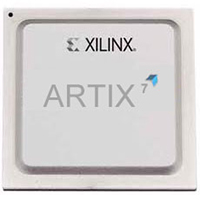By Xilinx Inc 616

The Xilinx Artix®-7 family of FPGAs has redefined cost-sensitive solutions by cutting power consumption in half from the previous generation while providing advanced functionality for high-performance applications. Designers can leverage twice the logic density for the same power budget. These low-end devices are built on the 28 nm high-performance, low-power (HPL) process to deliver best-in-class performance-per-watt for products like portable medical equipment, military radios, and compact wireless infrastructure. Artix-7 FPGAs meet the needs of size, weight, power, and cost (SWaP-C) sensitive markets like avionics and communications.
Artix-7 FPGAs are available in -3, -2, -1, -1LI, and -2L speed grades, with -3 having the highest performance. The -1LI and -2L devices are screened for lower maximum static power and can operate at lower core voltages for lower dynamic power. The -1L1 devices operate only at VCCINT = VCCBRAM = 0.95 V and have the same speed specifications as the -1 speed grade. The -2L devices can operate at either of two VCCINT voltages, 0.9 V and 1.0 V, and are screened for lower maximum static power. When operated at VCCINT = 1.0 V, the speed specification of a -2L device is the same as the -2 speed grade. When operated at VCCINT = 0.9 V, the -2L static and dynamic power is reduced.
Artix-7 FPGA DC and AC characteristics are specified in commercial, extended, industrial, expanded (-1Q), and military (-1M) temperature ranges. Except the operating temperature range or unless otherwise noted, all the DC and AC electrical parameters are the same for a particular speed grade (that is, the timing characteristics of a -1M speed grade military device are the same as for a -1C speed grade commercial device). However, only selected speed grades and/or devices are available in each temperature range. For example, -1M is only available in the defense-grade Artix-7Q family and -1Q is only available in XA Artix-7 FPGAs.| Features | ||
|
|
|
| Applications | ||
|
|